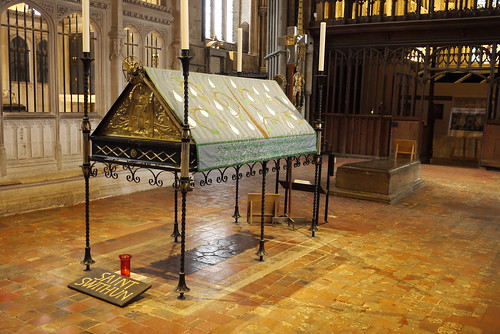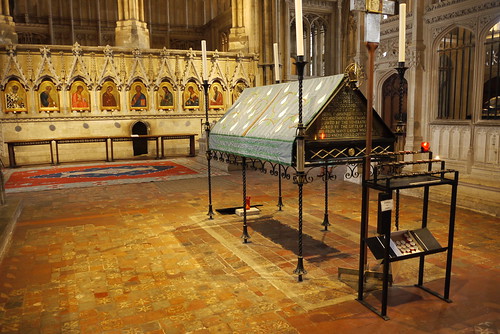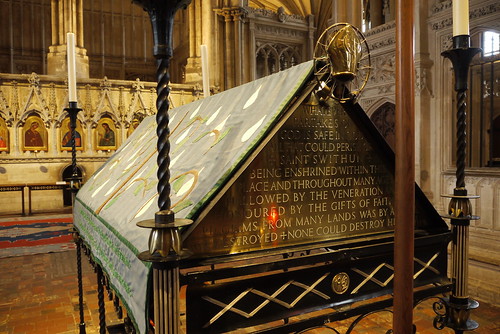St Swithun is the Saxon patron saint of Winchester Cathedral. Before the reformation his bones were displayed in a reliquary within the Benedictine Monastery. The reliquary and shrine to St Swithun was destroyed in 1538 by the commissioners of King Henry VIII.
The life of St Swithun, an Anglo-Saxon bishop, is rich in legend. A century after his death in 863, he was chosen as patron saint for the Cathedral’s Benedictine monastery. His bones, housed in a splendid reliquary, became famed for their healing powers. His cult lasted until the Reformation, when all traces of his shrine were swept away.
Who was St Swithun?
The story of St Swithun, the Cathedral’s much-loved Saxon patron saint, combines a handful of hard facts with many legends.
The facts are that he was born in Winchester around 800, became counsellor to the Saxon kings Egbert and Ethelwulf, and was Bishop of Winchester for the last 10 years of his life.
When he died in 863, he was buried in front of the west door of the Saxon Old Minster – you see its outlines traced in brick next to the Norman Cathedral. Here he rested for over a hundred years.
How did he become famous?
When Aethelwold, the reforming Bishop of Winchester, set up a new community Benedictine monks at Old Minster around 964, he decided they needed a new, purpose-made patron saint.
Bishop Swithun’s bones were dug up and placed them in a precious reliquary inside the building, given by King Edgar – an act later seen as against the saint’s wishes.
In the 11th century, Swithun’s relics were on the move again – this time, into the huge new Cathedral built by the Norman invaders. His Anglo-Saxon reliquary was carried with great ceremony to its new position behind the high altar, where it stayed until 1450.
His tomb became a major site for pilgrims, many seeking to be healed from illness. A short tunnel (the Holy Hole) allowed them to crawl right under his shrine, as close as possible to his miraculous healing powers.
In 1476, a new, even larger shrine was inaugurated at the far end of the building. It must have been a striking sight, festooned with gifts of silver, gold and jewels offered by grateful pilgrims.
What legends are told about him?
One legend claims that Swithun tutored the young Alfred the Great. Another says is that he built the first stone bridge over the River Itchen that runs through Winchester.
His most famous miracle tells of a simple act of human kindness to a poor woman. When crossing the bridge, she was jostled and dropped her basket of eggs. The saint took pity on her – and made her broken eggs whole.
One source claims that when Swithun died, he asked to be buried out of doors ‘where the feet of ordinary men could pass over him.’
This, and a possible mistranslation of a medieval text, may have given rise to the story that when the saint’s bones were moved inside the Old Minster on his feast day, 15 July 971, a terrible storm broke out, lasting for 40 days and nights.
This is the basis of the popular belief that if it rains on 15 July, it will rain for 40 days. Sadly, this claim has no basis in fact.
What happened to his shrine?
The cult of St Swithun and his shrine came to an abrupt end during the Reformation, when King Henry VIII seized control of the Catholic Church in England, and declared himself head of the Church of England.
On 21 September 1538, under cover of darkness at 3am in the morning, the king’s commissioners smashed it apart, and stole all the valuables. Three years later, a workman stopped up the Holy Hole.
Nothing remains of his once great shrine today, but you can see a modern memorial that marks the spot.
WHATEVER
PARTAKES OF
GOD IS SAFE IN GOD
ALL THAT COULD PERISH OF
+SAINT SWITHUN+
BEING ENSHRINED WITHIN THIS
PLACE AND THROUGHOUT MANY AGES
HALLOWED BY THE VENERATION AND
HONOURED BY THE GIFTS OF THE FAITHFUL
PILGRIMS FROM MANY LANDS WAS BY A LATER
AGE DESTROYED + NONE COULD DESTROY HIS GLORY











So, NOW we know!!!
Interesting
Wonderfully interesting post Such a shame the shrine no longer exists but good to see the spot marked by a more modern memorial. I really do hope I can visit Winchester one day!
Such a shame the shrine no longer exists but good to see the spot marked by a more modern memorial. I really do hope I can visit Winchester one day!
It is good that the spot is still remembered.
all of that great history about St Swithun… just to turn his reliquary into a collection of stones… the reformation messed up Christianity for a very long time Cherie….peter:)
Sadly, I think it is still messed up to some extent.
What a great information piece. I especially enjoyed reading about the legends.
I am glad you found it informative
true or not, it made for an interesting post with lovely photos, Cherie. i liked the part about making the eggs whole again.
I am glad you enjoyed it
I didn’t know the story of St Swithun, so I found this fascinating. I’m reminded again how different it would have been before the reformation when people worshipped the saints. And the destruction of the shrine was very brutal – it must have devastating to so many.
The reformation was quite brutal and it is sad looking back on the destruction.
A lot of interesting information there CherryPie. Talking of Cherry Pies, I’m off to Winchester to the Victorian Christmas Market on Wednesday. Of course I’ve been to Winchester several times, but this is my first Winter trip there. Wrap up warm and enjoy lots of mulled wine. You see, I’m going on a local WI coach trip. No driving for me. Last week I joined the same group on a trip to a similar market at Gloucester Quays. I also managed a trip round Gloucester Cathedral (a first for me) and the Inland Waterways Museum.
The ladies on the coach were interesting as well.
Merry Christmas
Bernard
You are honoured to be joining the WI ladies on their trips or perhaps it is they who have the honour of you company
You seem have followed in my footsteps with Gloucester Cathedral, Gloucester Keys and Winchester. I have visited them all this year
What did you think of Gloucester Cathedral?
It is lovely to hear from you again
I though the Cathedral was wonderful. I especially liked the little side chapel for departed Cathedral organists. I loved the printed music in the stained glass windows.
It’s the first time I’ve ever seen anything like this.
The only downside was that it snowed on me in the cloister garden!
I took shelter in the cafe and warmed myself with a hot chocolate.
Later, outside in the market I came across a stall selling mulled wine.
That warmed me up even more.
Our WI are only too pleased to fill seats on the coach. All are welcome. I guess we are ‘gender neutral’ in Bourne end. The lady sat next to me asked if I played the organ at the Marlow regatta (she was from Marlow you see). I said no, but I had been to Cookham Regatta every year and played. I told her that when she got home, she could go on YouTube and search for ‘Cookham Regatta’ and I would probably pop up, organ and all.
“No need to wait until I get home,” she said and promptly whipped out her Smart
Phone, loaded YouTube and the whole coach heard me play. What a laugh.
Regards
Bernard
I need to go back to Gloucester I missed the side chapel you mention and also the music in the stained glass windows…
It sounds like you had a lot of fun with your ladies on the coach
It’s called ‘Howell’s Window’ and I found it here on Flickr
https://www.flickr.com/photos/pefkosmad/8478427027
Thank you
Henry VIII again?
How predictable!
He initiated a lot of damage…